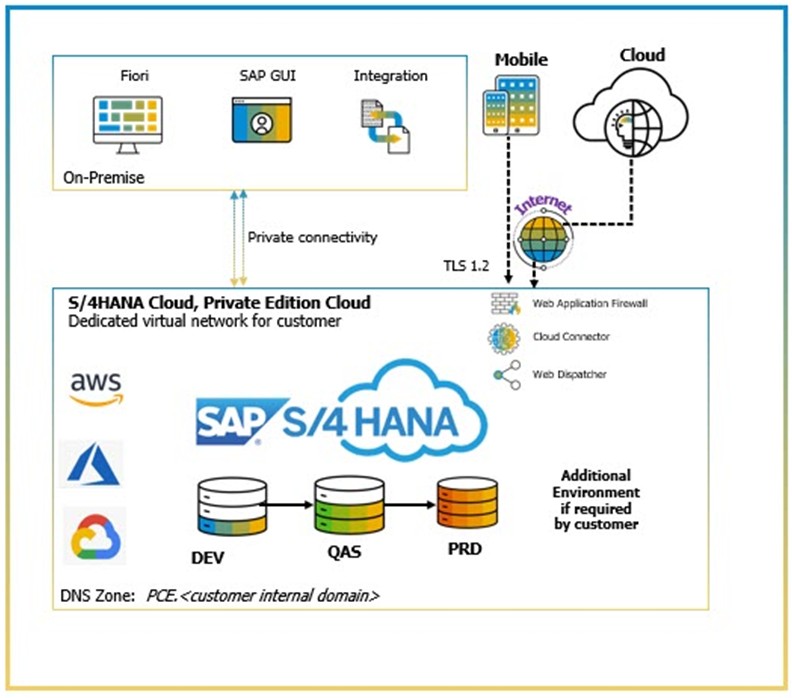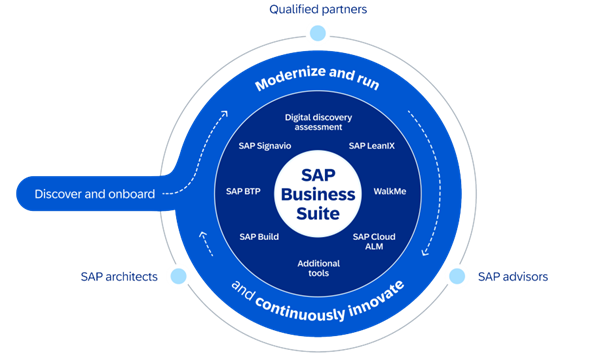Thought Leader – Wispmac Shah
For over 20 years, SAP ECC has been the digital backbone for businesses across industries. But times have changed. As technology continues to evolve and customer expectations shift, traditional ERP systems like ECC are starting to show their age. What once empowered organizations is now often holding them back.
SAP’s answer to modern business needs is RISE with SAP, offering a path to the cloud that’s built around flexibility, agility, and future-readiness. With SAP planning to end support for ECC by 2027, more and more companies are beginning to map out their migration plans.
SAP ECC Migration to RISE involves more than just a technical upgrade. It is a strategic decision that impacts operations, architecture, and organizational culture.
In this blog, we’ll break down what RISE includes, how SAP migration services can support the journey, and what technical considerations to keep in mind before and during the move.
What is RISE with SAP?
RISE with SAP stands out as more than just another product. It offers Business Transformation as a Service combining approaches to help companies move to the cloud while rethinking their business operations.
RISE brings together infrastructure, software, and services in one subscription rather than making companies handle multiple contracts. This approach makes the process easier and gives businesses a way to transform that adapts and grows with them.

Here’s what’s included in the package:
SAP S/4HANA Cloud, with public and private options
SAP Business Technology Platform (BTP) to integrate, manage data, and create custom solutions
SAP Signavio tools to examine and reshape business processes
SAP Business Network Starter Pack to work better with suppliers
Tools like Cloud ALM or Solution Manager to manage applications throughout their lifecycle
Cloud infrastructure run by SAP or major providers such as AWS, Microsoft Azure, or Google Cloud.
SAP ECC Migration to RISE simplifies contracts, reduces operational complexity, and shifts the focus from system maintenance to business value generation.
Why Move from SAP ECC to RISE with SAP?
The decision to migrate is both a technical and strategic one. Here are some of the main reasons organizations are making the move:
End of Support: ECC will no longer receive mainstream support after 2027. Staying on ECC beyond that point increases security, compliance, and cost risks.
Cloud Infrastructure: With RISE managing infrastructure which means no more hardware procurement, operating system patching, or database administration.
Operational Agility: S/4HANA offers faster performance, simplified data models, and a modern user experience, enabling quicker decision-making and real-time reporting.
Innovation Readiness: RISE provides access to artificial intelligence, machine learning, process automation, and other services through BTP.
Process Optimization: Tools such as Signavio enable businesses to discover inefficiencies and align operations to industry standards before going live on S/4HANA.
Single Responsibility Model: With RISE, there is one contract and one service-level agreement. This simplifies governance and reduces vendor coordination challenges.
SAP ECC Migration to RISE with SAP – Migration Paths
The approach you choose depends on your business goals, system complexity, and risk appetite.
1. System Conversion
This approach involves converting the existing ECC system to SAP S/4HANA within the RISE Private Cloud. It preserves configurations, custom code, and transactional history. Software Update Manager with Database. SAP migration services option allows a combined technical conversion and migration to the HANA database.
System conversion is often selected when the existing system is relatively healthy and aligned with the company’s future operating model.
Learn More – SAP S/4HANA Deployment Options: A Guide to Your Migration Strategy
2. New Implementation
In a new implementation, a fresh S/4HANA system is deployed and only essential master and transactional data from SAP ECC Migration. This method allows the business to adopt standard processes and modernize operations without carrying forward legacy technical debt. This approach is well-suited for companies seeking to standardize, simplify, or globalize their ERP landscape.
3. Selective Data Transition
This hybrid approach enables selective migration of business units, company codes, or specific data sets into a clean S/4HANA environment. It is especially useful for companies with multiple ECC instances or those undergoing mergers and acquisitions.
Partners or third-party tools often support this transition model, and it may involve a combination of system conversion and new implementation principles.
Technical Considerations
The SAP ECC Migration to RISE is not just about moving software. It touches infrastructure, applications, integrations, and data. The following are key technical considerations that must be addressed.
- Infrastructure Change
With RISE, SAP or a cloud provider manages your infrastructure. This includes provisioning servers, maintaining operating systems, patching databases, and ensuring availability. Your IT team will shift focus from infrastructure operations to application support and business process improvements.
Network architecture planning is also required. Connectivity between on-premise systems and the RISE environment must be secured and optimized, often through VPN tunnels or private cloud interconnects.
- Custom Code Analysis and Adaptation
Most ECC systems include custom ABAP code. Some of this code may rely on data structures or technologies that no longer exist in S/4HANA. SAP provides the Custom Code Migration App and the ABAP Test Cockpit to identify and remediate these issues during SAP ECC Migration.
The first step is to assess which custom code is still used and business-critical. Unused or obsolete code should be decommissioned. Active and relevant code must be adjusted to align with HANA data models and performance expectations.
- Data Migration
The data SAP migration services strategy depends on the selected migration path.
In system conversion, all data is migrated in-place using SUM with DMO. This includes historical transactions, master data, and configurations.
In a new implementation, businesses often migrate only current and relevant data using tools such as the Migration Cockpit. Data cleansing is recommended before migration to improve data quality and reduce transformation effort.
Data consistency and reconciliation are critical. Businesses should plan for rigorous validation, both before and after SAP ECC Migration.
Read Success Story – ECC to SAP S/4HANA Migration for Leading Manufacturing Company
- Business Process Analysis with Signavio
Signavio, included in RISE, enables organizations to visualize current ECC processes, identify inefficiencies, and compare their operations against industry benchmarks.
This analysis supports fit-to-standard workshops, where teams map their business requirements to S/4HANA capabilities. The goal is to minimize customizations and take full advantage of best-practice configurations.
- Integration and Extensions
During SAP ECC Migration, many integrations are built directly into the ERP system. RISE encourages a clean core strategy, where custom logic and interfaces are developed outside the ERP using SAP Business Technology Platform.
SAP Integration Suite supports process orchestration and connectivity between SAP and non-SAP systems. Extensions can be built using services such as Build Apps, CAP (Cloud Application Programming model), or other BTP services.
Shifting to this architecture enables faster innovation cycles and simplifies future upgrades.
Project Lifecycle with SAP Activate
SAP Activate is the implementation methodology used for all S/4HANA and RISE projects. It includes predefined phases, templates, tools, and best practices.

- Discover Phase
In this initial phase, organizations evaluate their current landscape, identify business goals, and build a business case. Tools like SAP Readiness Check and Signavio help understand technical debt, custom code usage, and process complexity.
- Prepare Phase
Here, project teams are formed, governance is established, and system scoping is finalized. Pre-project checks are run, and a roadmap is created.
- Explore Phase
Fit-to-standard workshops are conducted to validate business requirements against standard functionality. Gaps are identified and change impact assessments begin. Custom code adaptation plans are created in this phase.
- Realize Phase
The system is built, data migration is executed, and integration scenarios are developed. Functional and technical testing are performed in multiple cycles.
- Deploy Phase
Cutover planning, training, and go-live rehearsals are completed. The system goes live, and hypercare support is initiated to stabilize operations.
- Run Phase
Post go-live, organizations transition to steady-state operations using SAP Cloud ALM or Solution Manager. Focus shifts to continuous improvement, innovation adoption, and operational monitoring.
Final Thoughts
SAP ECC Migration to RISE with SAP is a complex but rewarding journey. It enables organizations to adopt modern technology, reduce costs, simplify operations, and become more responsive to changing business needs.
Success requires more than tools and software. It depends on early planning, cross-functional collaboration, strong project governance, and a clear focus on business outcomes.
If your organization is still running SAP ECC, now is the time to start planning. Contact Stridely Solutions for expert guidance and support to ensure seamless migration with our SAP migration services.


